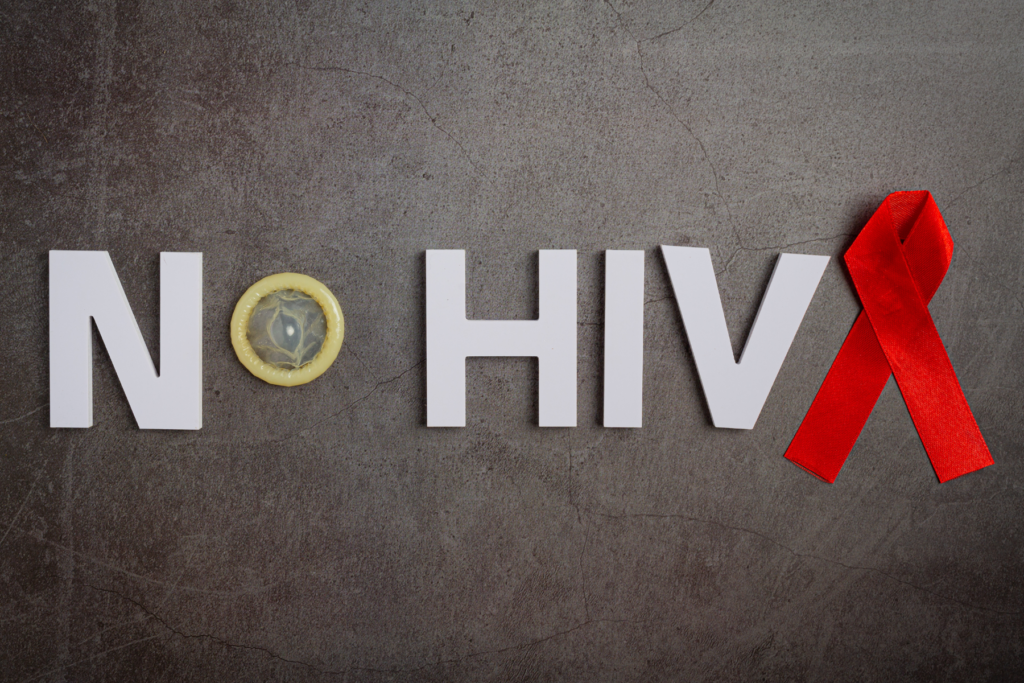Breaking the Silence: HIV+ Awareness Day

[ 9.5 min Read ]
In the realm of assisted reproductive technologies, there exists a profound journey for individuals living with HIV.
Can an HIV+ Intended Parent work with a Surrogate?
We’re writing this today because it’s HIV awareness day, and we aim to shed light on HIV awareness, debunking myths, and unraveling the intricate processes that allow intended parents to realize their dream of parenthood through surrogacy and egg donation. It’s a question we get that is more common than you might think.
Navigating the surrogacy journey when the intended father is HIV+ involves careful considerations, medical advancements, and collaborative efforts to ensure a healthy and successful process.
Let’s answer some questions about Sperm Washing!
What is Sperm Washing?
In cases where the intended parent is HIV+, a crucial step is sperm washing. This process separates HIV from the sperm, reducing the risk of transmission during fertilization. Advanced reproductive technologies, including sperm washing, have made it possible for individuals with HIV to safely contribute to the creation of embryos. Basically, sperm washing is a laboratory procedure designed to separate sperm from other components in the semen, including the HIV virus. The primary goal is to obtain sperm that is free from HIV particles, allowing for safer fertilization and embryo creation.
Sperm washing dramatically reduces the risk of HIV transmission from the intended parent to the surrogate and, subsequently, to the developing fetus. The silver lining to this, for HIV-positive individuals, sperm washing opens the door to biological parenthood without compromising the health of the surrogate or the child. The development of sperm washing techniques represents a milestone in reproductive medicine, showcasing the ongoing commitment to making family-building accessible to diverse individuals. (hooray!)
Sperm washing is a testament to the intersection of science, compassion, and the desire to create opportunities for all individuals, regardless of their health status. In surrogacy, this technique plays a vital role in ensuring a safe and successful journey for HIV-positive intended parents and their surrogates.
How does sperm washing work?
Collection: The journey begins with the collection of semen, usually through masturbation. The sample is then delivered to the laboratory within a specific timeframe to maintain sperm viability.
Centrifugation: Once in the lab, the semen undergoes centrifugation, a process where it’s spun at high speeds. This step effectively separates the sperm from the seminal fluid, with the denser sperm settling at the bottom of the tube.
Washing: The separated sperm is then washed with a special culture medium. This washing not only further separates the sperm from any remaining contaminants but also provides a medium conducive to their survival and motility.
Selection: Post-washing, the embryologist carefully selects the healthiest and most active sperm for use in assisted reproduction. This ensures that only the sperm with optimal fertility potential are introduced to the reproductive process.
Insemination: The processed sperm can be used in various assisted reproductive techniques, including intrauterine insemination (IUI) or in vitro fertilization (IVF). Whether introducing the sperm directly into the uterus or combining it with eggs in a laboratory setting, the enriched sperm sample increases the chances of successful fertilization.
Is sperm washing effective in preventing HIV transmission?
Yes, sperm washing is an effective method in preventing HIV transmission during assisted reproductive techniques. This technique is particularly crucial for couples where the male partner is HIV positive and wishes to conceive while minimizing the risk of transmitting the virus.
Just keep in consideration that while sperm washing is highly effective, it is crucial to note that no medical procedure can guarantee absolute zero risk. Close coordination with healthcare professionals, adherence to safety protocols, and thorough screening are integral components of a comprehensive approach to reproductive health in the context of HIV. We’d also like to note that there are no known cases of transmission of HIV to a Surrogate once sperm washing has been done.
Can sperm washing be used for other infections?
While sperm washing is effective for certain infections, its application is limited to those where the virus or bacteria is present in the seminal fluid. It’s not a universal method for all types of infections. The decision to use sperm washing for a specific infection is based on thorough medical evaluation and consultation with healthcare professionals.
It’s important to note that the effectiveness of sperm washing can vary depending on the nature of the infection. Each case requires careful consideration, and healthcare providers will assess factors such as the type and concentration of the infectious agent, the health of the individual, and the reproductive goals of the couple.
In summary, while sperm washing is a valuable technique for reducing the risk of transmission of certain infections, its use is context-specific and determined by the characteristics of the infection in question. Always consult with qualified healthcare professionals to assess the suitability of sperm washing based on individual circumstances and medical history.
Does sperm washing affect the success of assisted reproductive procedures?
The success of assisted reproductive procedures, such as in vitro fertilization (IVF), can be influenced by various factors, and sperm washing is a crucial step in this process. Sperm washing is performed to separate high-quality sperm from seminal fluid and potential contaminants. The goal is to enhance the chances of a successful fertilization and implantation.
Here are some ways in which sperm washing can impact the success of assisted reproductive procedures:
Concentration of Healthy Sperm: Sperm washing concentrates healthy, motile sperm, which are essential for fertilizing an egg. This can increase the likelihood of successful fertilization during IVF.
Removal of Seminal Fluid and Contaminants: The process of sperm washing removes seminal fluid, debris, and potential contaminants, reducing the risk of introducing harmful substances into the uterus during procedures like intrauterine insemination (IUI) or IVF.
Minimizing Irritants: The removal of prostaglandins and other substances during sperm washing helps minimize uterine contractions, which can improve the chances of successful embryo implantation.
Enhancing Sperm Quality: Sperm washing can contribute to selecting healthier and more viable sperm, which is particularly beneficial for individuals with male factor infertility.
Reducing the Risk of Infection: Sperm washing is crucial when dealing with infections, such as HIV. By removing the virus from the seminal fluid, the risk of transmitting infections to the recipient or the resulting embryo is significantly reduced.
While sperm washing is an important step, the overall success of assisted reproductive procedures also depends on various other factors, including the health of the eggs, the woman’s reproductive health, and the overall quality of the IVF laboratory.
It’s essential to consult with fertility specialists who can assess individual circumstances and provide personalized guidance on the most suitable assisted reproductive techniques.
Is sperm washing a one-time process?
Sperm washing is typically performed as needed, corresponding to specific assisted reproductive procedures. It is not a one-time process in the sense that it can be repeated for each reproductive attempt, such as in vitro fertilization (IVF) or intrauterine insemination (IUI).
While sperm washing is a routine part of many assisted reproductive technologies, its repetition depends on the fertility treatment plan and the number of reproductive attempts. Each time a new cycle or procedure is initiated, sperm washing is typically performed to ensure the use of the highest quality sperm for fertilization.
Are there any risks or side effects of sperm washing?
Sperm washing is generally considered a safe and routine procedure in assisted reproductive technologies, but like any medical procedure, it’s important to be aware of potential risks and side effects.
It’s crucial for individuals or couples undergoing fertility treatments to have thorough discussions with their healthcare providers. This includes understanding the specific procedures involved, potential risks, and how any concerns or complications will be managed. The medical team will provide personalized guidance based on the individual’s health, the specific fertility issues, and the chosen assisted reproductive procedures.

Health Monitoring...
Continuous monitoring of the HIV-positive intended parent’s health is paramount. Maintaining viral suppression through antiretroviral therapy (ART) is not only crucial for personal health but also contributes to a safer surrogacy process.
Maintaining Viral Suppression: The cornerstone of health management for an HIV-positive intended parent is adhering to antiretroviral therapy (ART). This not only contributes to personal health but also plays a pivotal role in creating a safer environment for the surrogacy process. Intended parents and surrogates work closely with healthcare professionals to devise personalized strategies for risk mitigation. This may involve specific ART adjustments or additional precautions during conception and pregnancy.
Health Monitoring Protocol: Rigorous health monitoring, including regular check-ups and assessments, is implemented for the HIV-positive intended parent. This is to ensure that their viral load remains undetectable, reducing the risk of transmission during conception and pregnancy.
This goes without saying that Doctor support is important here, as well as having educational and psychological support. Surrogacy involving HIV-positive intended parents requires a multidisciplinary approach, encompassing medical, legal, and emotional aspects. By maintaining viral suppression, implementing rigorous health monitoring, and fostering open communication, the surrogacy journey can proceed safely and with the well-being of all parties as the top priority.
Furthering Education and Support
In attempt to continue our HIV awareness here, we wanted to share some further awareness support options… things that we can all do to help. Some might be a very involved options, but just wanted to get you thinking (inspired!) if this is something you feel passionate about.
Community Awareness:
- Education Initiatives: Launching educational programs to inform communities about HIV, assisted reproduction, and the intersection of the two. This can help dispel myths and reduce stigma.
- Community Dialogues: Facilitating open conversations to address concerns, provide accurate information, and foster understanding. Breaking the silence contributes to building supportive communities.
Advocacy Efforts:
- Supporting HIV Advocacy Groups: Collaborating with existing HIV advocacy organizations to amplify the voices of those affected and address challenges related to assisted reproduction.
- Policy Advocacy: Engaging in advocacy efforts to influence policies that protect the rights of HIV-positive individuals in assisted reproduction, fostering an environment of inclusivity.
Legal Protections:
- Anti-Discrimination Laws: Advocating for and supporting the implementation of laws that protect individuals from discrimination based on their HIV status, ensuring fair treatment in assisted reproduction.
- Reproductive Rights Legislation: Participating in initiatives that advocate for comprehensive reproductive rights, including those related to assisted reproduction for HIV-positive individuals.
Medical Professional Training:
Inclusive Training Programs: Collaborating with medical institutions to develop training programs that sensitize healthcare professionals to the needs and rights of HIV-positive individuals in assisted reproduction.
Public Awareness Campaigns:
Media and Social Media Campaigns: Leveraging media channels and social platforms to launch campaigns that challenge stereotypes, provide accurate information, and encourage empathy.
Support Networks:
- Building Safe Spaces: Establishing support networks where individuals and families affected by HIV can share experiences, seek guidance, and find emotional support.
- Peer Mentoring Programs: Creating programs that connect individuals who have gone through assisted reproduction as HIV-positive with those considering similar journeys.
Educational Resources:
Accessible Information: Ensuring that educational resources about assisted reproduction and HIV are readily available and accessible to the public. This includes online platforms, pamphlets, and community workshops. You can also speak with your doctor!
Research and Publications:
Encouraging Research: Supporting research initiatives that explore the experiences, challenges, and successes of HIV-positive individuals in assisted reproduction. Sharing findings through publications contributes to the body of knowledge.

Surrogacy with HIV-positive individuals is a testament to the advancements in reproductive medicine and the commitment to inclusivity in family-building journeys. Through education, support, and compassion, we can break down barriers and create a more inclusive and understanding world for all involved in the surrogacy process!
Breaking the stigma associated with HIV in the context of assisted reproduction requires a multifaceted approach. By advancing community awareness, engaging in advocacy, advocating for legal protections, enhancing medical professional training, and fostering support networks, we can create a more inclusive and empathetic environment for individuals and families affected by HIV.

